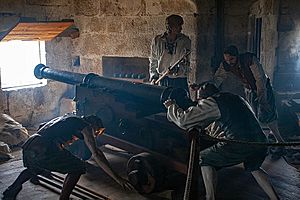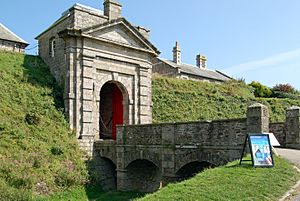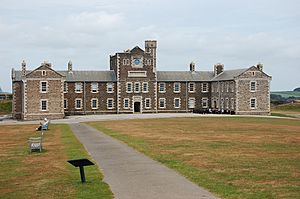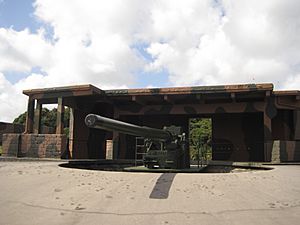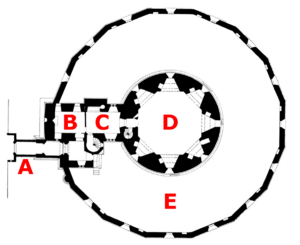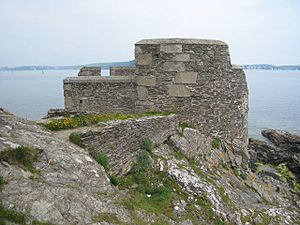Pendennis Castle facts for kids
Quick facts for kids Pendennis Castle |
|
|---|---|
| Kastel Penndinas | |
| Falmouth, Cornwall, England | |
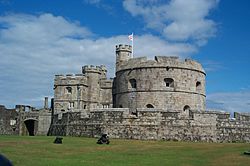
16th-century keep and gun platform
|
|
| Lua error in Module:Location_map at line 416: Malformed coordinates value. | |
| Coordinates | ACoordinates: Unknown argument format |
| Type | Device Fort |
| Site information | |
| Owner | English Heritage |
| Open to the public |
Yes |
| Condition | Intact |
| Site history | |
| Built | 1540–42 |
| Built by | John Killigrew |
| Events | English Civil War Second World War |
|
Listed Building – Grade I
|
|
| Official name | Pendennis Castle |
| Designated | 23 January 1973 |
| Reference no. | 1270096 |
| Official name | Pendennis peninsula fortifications |
| Designated | 9 October 1981 |
| Reference no. | 1012134 |
Pendennis Castle (in Cornish, Kastel Penndinas) is a strong fort built by King Henry VIII in England. It stands near Falmouth, Cornwall, and was constructed between 1540 and 1542. The castle was part of the King's plan to protect England from attacks by France and the Holy Roman Empire. It guarded the important Carrick Roads waterway at the mouth of the River Fal.
The castle started with a round tower, called a keep, and a platform for guns. Later, more walls and ramparts were added to protect against threats from Spain. Pendennis Castle played a big role in the English Civil War. It was held by the King's supporters, the Royalists, and was only captured by Parliament after a long fight in 1646.
After the war, King Charles II improved the castle. Over the years, its defenses were updated many times, especially during the 1700s and 1790s when there were worries about French invasions. During the Napoleonic Wars, the castle had as many as 48 guns. In the late 1800s, an electric minefield was placed in the River Fal, controlled from Pendennis and St Mawes Castle.
The castle was used in both the First World War and the Second World War. It saw action against German planes during World War II. However, by 1956, it was no longer needed for defense and was closed as a military base. Today, English Heritage looks after Pendennis Castle. It is a popular place for visitors to explore history and learn about old forts.
Contents
History of Pendennis Castle
Building the Castle (1500s)
Pendennis Castle was built because of problems between England, France, and the Holy Roman Empire. For a long time, local lords were in charge of coastal defenses. But King Henry VIII decided to take a bigger role. He needed to protect England from possible invasions.
In 1533, King Henry VIII made a big change by ending his marriage. This upset the Holy Roman Emperor, who was related to his wife. France and the Empire then became allies against Henry. The Pope even encouraged them to attack England. Because of this, Henry ordered new forts to be built along the English coast in 1539. This plan was called the "Device programme."
The Carrick Roads waterway was a very important place for ships coming from the Atlantic Ocean. A small gun tower, called the Little Dennis Blockhouse, was built there in 1539. Plans were made for five more castles, but only Pendennis and St Mawes Castle were built. They were placed on opposite sides of Carrick Roads to protect the entrance with their guns. John Killigrew, a local leader, likely managed the building of Pendennis. He became its first captain. The castle cost about £5,614 to build, which was a lot of money back then!
Early Years of Operation
The Killigrew family managed Pendennis Castle for many years. The captains of Pendennis and St Mawes castles often argued. In 1630, they even had a legal fight about who had the right to check ships coming into the harbor. The Admiralty eventually decided they should share this job.
After 1558, England made peace with France, so the first invasion threat passed. However, Spain became a bigger threat to England's southwest. War broke out in 1569. To protect the castle from land attacks, an earthwork was built. More guns were also added. The number of soldiers at the castle changed a lot. In 1578, there were 100 men, but in 1599, there were 200.
The Spanish threat continued. In 1593, Spanish raiders destroyed the Killigrew family home. In 1595, four Spanish ships attacked towns along the coast. A large Spanish fleet tried to attack Pendennis in 1597, but bad weather stopped them. This made the English government very worried. They realized the castle needed stronger defenses.
So, between 1597 and 1600, a military engineer named Paul Ivey built a new ring of defenses. This included earthworks, gun openings, bastions, and a stone ditch around the old castle. About 400 local workers helped build these new defenses.
In the early 1600s, England was peaceful, and Pendennis Castle was not well looked after. Soldiers sometimes had to find food like limpets from the shore because their pay was late. Still, a new gatehouse was added around 1611. When war with Spain started again in 1624, another defensive line with guns was built across the peninsula in 1627.
English Civil War and Restoration
When the English Civil War began in 1642, Pendennis Castle was held by the King's supporters, the Royalists. The nearby town of Falmouth was important for their supplies. The Carrick Roads harbor was also a base for Royalist ships. As the war turned against the Royalists, Prince Charles briefly stayed at the castle in early 1646.
Soon after Charles left, a large army led by Thomas Fairfax entered Cornwall. Most other Royalist strongholds had already fallen. St Mawes Castle surrendered quickly. But Pendennis Castle, defended by about 1,000 soldiers led by Sir John Arundell, refused to give up. They were determined to fight.
Parliamentary forces attacked the castle from land and sea. Captain Batten's ships blocked the harbor, stopping new supplies from reaching the castle. By July, the soldiers inside were running out of food. Sir John Arundell finally agreed to surrender on August 15. About 900 survivors, many very sick from hunger, left the fort two days later. Pendennis was one of the last Royalist forts to fall.
After the war, Parliament kept soldiers at the castle. In 1647, some soldiers mutinied because they felt they weren't paid enough. They held Parliamentary officials hostage until their demands were met. Later, a smaller, more trusted group of soldiers was put in charge. During the time England had no king, the castle was used to imprison a writer named William Prynne.
When King Charles II returned to the throne in 1660, Sir Peter Killigrew became the new captain. Worries about invasion continued, so another gun battery was built at Crab Quay. A new guard barracks and gate were also added around the end of the century.
1700s and 1800s Upgrades
Pendennis Castle remained in use throughout the 1700s and 1800s. In 1714, an inspection found the castle in poor condition. Its walls were crumbling, and ditches were overgrown. Not much was done until the 1730s, when the castle was greatly improved. The inside was changed, the walls were rebuilt, and new 18-pounder cannons were installed.
During the American Revolutionary War, France became an ally of the American revolutionaries. This led to war with Britain in 1778. Falmouth became an important military base. In 1795, the government bought the castle land from the Killigrew family. They strengthened the fort against new invasion threats. More guns were added, and a new gun position called the Half-Moon Battery was built. New barracks and other buildings were also constructed inside the fort. At its busiest, the castle had up to 48 guns.
After the Napoleonic Wars ended in 1815, Pendennis was not well maintained. Many of its guns stopped working, and some buildings fell apart. In the 1850s, new fears of a French invasion led to more investment. Nineteen new 32- and 56-pounder guns were installed. Falmouth remained an important harbor for the Royal Navy.
In 1885, an electrically controlled minefield was placed across Carrick Roads. It was controlled from both Pendennis and St Mawes castles. New, fast-firing guns were also added to protect against enemy torpedo boats.
20th and 21st Centuries
In 1902, the 105th Regiment Royal Garrison Artillery took over the castle. New barracks were built for them. A signal station was put on top of the old keep to talk with ships. The castle was strengthened by reserve soldiers during the First World War. It continued to protect the harbor and was used for training. After the war, the castle's old buildings were put under the care of the Ministry of Works in 1920. By 1939, all the artillery had been removed.
Pendennis Castle was rearmed at the start of the Second World War. New guns were installed, and zig-zag trenches were dug for protection. The 16th-century fort became the headquarters for Falmouth Fire Command, which managed all the guns in the area. In 1943, new radar-controlled 6-inch guns were added. Falmouth was important for the D-Day invasion of France in 1944. The guns at Pendennis helped defend against German E-boats. After the war, the castle was still used for training, but it was no longer needed for defense. It was officially closed in 1956.
The entire Pendennis site was then opened to visitors. The Ministry of Works focused on the old 16th-century castle. Many newer military buildings were removed. The barracks were used as a youth hostel from 1963 to 2000. English Heritage took over the castle in 1984. They started to focus on preserving its more modern features too. A lot of work was done in the 1990s to fix up the castle and add new things for visitors. Today, Pendennis Castle is managed by English Heritage as a tourist attraction. It is a very important historical building, protected by law.
Castle Architecture
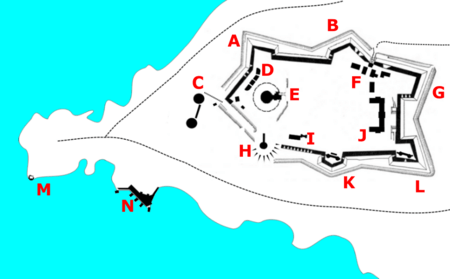
Pendennis Castle sits at the end of a piece of land sticking out into the sea. It looks over Carrick Roads and the ocean. The castle has the original 16th-century fort, surrounded by outer defenses. These outer defenses were built in the Elizabethan era and changed over the years. There are also more gun batteries and a blockhouse closer to the water.
Historic England says Pendennis is "one of the finest examples of a post-medieval defensive promontory fort in the country." This means it's a great example of a fort built on a headland after the Middle Ages. English Heritage calls it "one of the finest surviving examples of a coast fortress in England."
Outer Walls and Defenses
The main entrance to the castle is on the western side of the outer walls, called ramparts. The gatehouse was built around 1700 and has a classic design. A stone bridge from the mid-1800s crosses the ditch outside. The ramparts are made of stone with ditches for protection. They have angled parts called bastions, which allowed guns to fire in many directions. This was a new idea in England when they were built around 1600.
North of the gatehouse are the Smithwick and Carrick Mount bastions. The Carrick Mount bastion has a fast-firing gun battery from 1903. Further along the ramparts, the East Bastion also has two spots for quick-firing guns from 1902. It has underground rooms for storing ammunition, which were used as a plotting room for guns in World War II. The Nine-Gun Battery, built in the 1730s, has nine openings for guns.
In the southeast corner, the One-Gun Battery once held a "disappearing gun." This gun was designed to drop back behind a steel shield after firing. It was built in 1895 but didn't work well, so the gun was removed in 1913. However, the gun position is still there and is a rare example of this type of weapon. Other bastions like Bell, Ravelin, Pig's Pound, and Horse Pool protect the southern and western parts of the ramparts. You can see many types of guns around the defenses, including old 19th-century cannons and 20th-century anti-aircraft guns.
Inside the Main Castle
At the very center of the castle is the original 16th-century fort built by King Henry VIII. It's made of granite stone. It has a round keep (main tower) surrounded by a gun platform. You enter through a bridge and a front building. The keep has very thick walls, about 3.36 meters (11 feet) thick, and is octagonal inside.
The basement of the keep was once a kitchen and storage area. The ground floor was first meant for guns but was changed to living quarters for the soldiers. The first floor has another gun room with seven gun openings. It is set up to look like it did in the 1500s. The roof also has seven gun openings and a lookout tower.
The gun platform around the keep has 16 sides and 14 gun openings. The two-story front building was added later in the 1500s. It had three rooms on each floor, connected by a spiral staircase. This building was originally for the castle's captain. Its entrance was protected by a portcullis, a heavy gate that could be lowered. The roof was also designed for defense with handguns. The stone bridge to the castle was built in 1902. The original gatehouse at the front was removed in the early 1900s.
The rest of the fort's inside area once had many military buildings. Most of these have been removed and are now a large grassy area called a parade ground. Some buildings that still stand include the Royal Garrison Artillery barracks. These were built between 1900 and 1902 and could house 140 soldiers. There are also bungalows for officers, a storehouse from the Napoleonic Wars, and two guard barracks from 1700. Other surviving buildings include a 19th-century shed for field equipment and an 18th-century gunpowder storage building.
Outside Defenses
There are three defensive spots outside the main castle walls. To the south, you can reach the Half-Moon Battery through an underground passage. This battery was built in 1793 and updated in 1895 and 1941. It has two camouflaged gun houses with 6-inch guns from World War II. During the war, 99 soldiers worked here.
Further south, near the water, is the Little Dennis Blockhouse. This D-shaped gun position dates back to 1539. It was changed in the 1540s and later became part of a larger fort covering Pendennis Point. The outside of the blockhouse and its lookout tower are still in good condition. Just along the shoreline to the northeast is the Crab Quay Battery. These defenses were first built in the 1500s to stop landings on the headland. They were greatly updated in 1902.
Cornish Wrestling at the Castle
Many Cornish wrestling tournaments were held at Pendennis Castle during the 1800s. These events were for both the public and for soldiers, like the Duke of Cornwall's Artillery Volunteers in 1883.
See also
- Captain of Pendennis Castle
- Castles in Great Britain and Ireland
- List of castles in England


